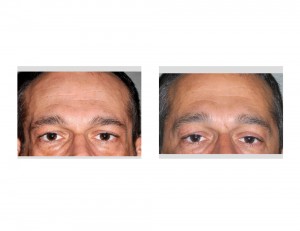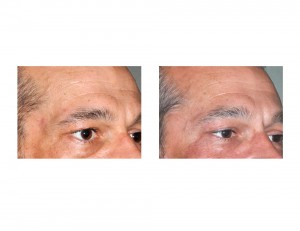Background: Facial lipoatrophy is the loss of facial fat which has various causes. Genetics, aging, weight loss and side effects of medications can all create variable degrees of facial fat loss. While fat exists throughout the face in the subcutaneous plane and around the eyes, the largest concentrated fat depot is in the buccal space. It is this fat area that is mosts severely affected in all degrees of facial lipoatrophy.
Known as the buccal or Buchat’s fat pad, it is located deep in the face between various facial and masticatory muscles underneath the cheek bone. While it is called the buccal pad because of its primary location, it has numerous extensions or fingers into the pterygoid and temporal regions. Thus when loss of part or even all of the buccal fat pad occurs, temporal hollowing ensues along with submalar indentation.
The treatment of temporal hollowing is most commonly done by a variety of injectable filler materials. Hyaluronic acid-based and particulated fillers are office treatment methods while fat injections is more of a surgical approach. While these injection treatments for temporal hollowing can be effective, they are rarely permanent, may require multiple treatments, and are prone to irregularities and asymmetry.
Case Study: This 45 year-old male requested treatment for generalized facial lipoatrophy. One of his areas of concern was his very deep temporal hollows which were very concave and whose depth was well below the level of the zygomatic arch. This gave him a very skeletonized appearance across the bitemporal region.


Placement of an implant in the subfascial temporal plane is a very easy dissection and pocket to create. This pocket location for the temporal implant requite no form of fixation as it can not migrate below the level of the zygomatic arch due to the narrow space behind the arch and the blocking effect of the coronoid process of the mandible below it.
Temporal implant augmentation offers a simple surgical solution that is both permanent, has yet to reveal any significant medical risks, and involves minimal discomfort and swelling. It has the fastest recovery of any of the facial implant procedures.
Case Highlights:
1) Temporal hollowing is a major manifestation of significant forms of facial lipoatrophy.
2) A soft silicone temporal implant is a new method to permanently correct temporal hollowing by muscle augmentation.
3) Temple implant augmentation is a simple surgery that has virtually no significant recovery or swelling associated with it.
Dr. Barry Eppley
Indianapolis, Indiana


